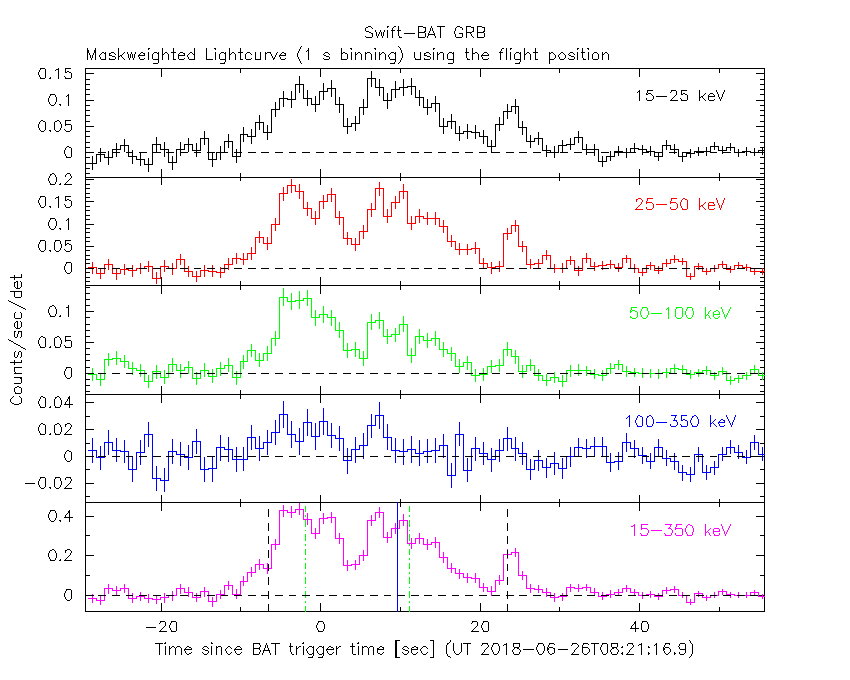
P.A. Evans (U. Leicester), D.N. Burrows (PSU) and A.A. Breeveld (UCL-MSSL) for the Swift team
At 08:21:16 UT, the Swift Burst Alert Telescope (BAT) triggered and located GRB 180626A (trigger=844615) (Evans et al. GCN Circ. 22850). Swift slewed immediately to the burst. At the time of the trigger, the initial BAT position was 131° from the Sun (9.9 hours East) and 34° from the 97%-illuminated Moon. Table 1 contains the best reported positions from Swift, and the latest XRT position can be viewed at http://www.swift.ac.uk/xrt_positions.
Evans et al. (GCN Circ. 22850) reported the discovery with UVOT of an optical afterglow. Table 2 is a summary of GCN Circulars about this GRB from observatories other than Swift.
Standard analysis products for this burst are available at https://gcn.gsfc.nasa.gov/swift_gnd_ana.html.
As reported by Krimm et al. (GCN Circ. 22862),
the BAT ground-calculated position is RA, Dec = 243.569, 14.759 deg which is RA(J2000) = 1
The mask-weighted light curve (Figure 1) shows a multi-peaked structure.
The first peak is from approximately T-10 to T+5 s, with a second overlapping peak from T+5 to T+20 s, followed by a weaker peak from T+20 to T+30 s.
The time-averaged spectrum from T-10.01 to T+25.59 s is best fit by a power law with an exponential cutoff.
This fit gives a photon index 1.64 ± 0.27, and
The results of the batgrbproduct analysis are available at https://gcn.gsfc.nasa.gov/notices_s/844615/BA/.
Analysis of the initial XRT data was reported by Burrows et al. (GCN Circ. 22860). We have analysed 24 ks of XRT data for GRB 180626A, from 129 s to 288.0 ks after the BAT trigger. The data are entirely in Photon Counting (PC) mode. The enhanced XRT position for this burst was given by Osborne et al. (GCN Circ. 22852).
The light curve (Figure 2) can be modelled with an initial power-law decay with an index of α=0.39 ± 0.04, followed by a break at T+9120 s to an α of 1.23 (+0.08, -0.07).
A spectrum formed from the PC mode data can be fitted with an absorbed power-law with a photon spectral index of 2.03 (+0.11, -0.10). The best-fitting absorption column is 2.3 ± 0.4 x 1
A summary of the PC-mode spectrum is thus:
Total column: 2.3 ± 0.4 x 1
Galactic foreground: 3.5 x 1
Excess significance: 8.9 σ
Photon index: 2.03 (+0.11, -0.10)
The results of the XRT team automatic analysis are available at http://www.swift.ac.uk/xrt_products/00844615.
The Swift/UVOT began settled observations of the field of GRB 180626A 123 s after the BAT trigger
(Breeveld and Evans GCN Circ. 22857).
A fading source consistent with the XRT position (Osborne et al. GCN Circ. 22852) and also seen by Martone et al. (GCN Circ. 22854) and Troja et al. (GCN Circ. 22855) is detected in the initial UVOT exposures.
Table 3 gives preliminary
magnitudes using the UVOT photometric system
(Breeveld et al. 2011, AIP Conf. Proc., 1358, 373).
No correction has been made for the expected extinction in the Milky Way
corresponding to a reddening of

Figure 1. The BAT
mask-weighted light curve in the four individual and total
energy bands. The units are counts

Figure 2. The XRT light curve.
Any data from a crosshatched region are not included in the fit.
| RA (J2000) | Dec (J2000) | Error | Note | Reference |
|---|---|---|---|---|
| 1 |
+14°45'25.5" | 0.81" | UVOT-initial | Evans et al. GCN Circ. 22850 |
| 1 |
+14°45'25.5" | 1.4" | XRT-final | UKSSDC |
| 1 |
+14°45'24.9" | 1.8" | XRT-enhanced | Osborne et al. GCN Circ. 22852 |
| 1 |
+14°45'32.8" | 1.0' | BAT-refined | Krimm et al. GCN Circ. 22862 |
| Band | Authors | GCN Circ. | Subject | Observatory | Notes |
|---|---|---|---|---|---|
| Optical | Elenin et al. | 22853 | ISON-MN optical observations | ISON-NM | |
| Optical | Martone et al. | 22854 | LCO Haleakala observations | LCO | detection |
| Optical | Troja et al. | 22855 | RATIR Optical Detection | RATIR | detection |
| Optical | Watson et al. | 22859 | COATLI Optical Detection | COATLI | detection |
| Optical | Zheng and Filippenko | 22861 | KAIT Optical Upper Limit | KAIT | upper limits |
| Optical | Watson et al. | 22865 | RATIR Optical Observations | RATIR | |
| Optical | Mazaeva et al. | 22870 | TSHAO optical upper limit | Zeiss-1000 | upper limits |
| Gamma-ray | Gotz et al. | 22851 | A long GRB detected by INTEGRAL | INTEGRAL | Fluence=2x1 |
| Gamma-ray | Kozlova et al. | 22869 | Konus-Wind observation | Konus-Wind | Fluence=7.21(-0.79,+0.97)x1 |
| Other | Coughlin et al. | 22871 | Zwicky Transient Facility Follow-Up of a Fermi Short GRB (Trigger 548793993) |
| Filter | Exp(s) | Mag | ||
|---|---|---|---|---|
| whit |
123 | 273 | 147 | 20.57 ± 0.22 |
| white | 633 | 1033 | 190 | >21.4 |
| v | 665 | 6473 | 452 | >20.2 |
| b | 591 | 5858 | 246 | >20.4 |
| u | 336 | 6936 | 529 | >20.7 |
| w1 | 714 | 6882 | 432 | >21.0 |
| m2 | 5043 | 6677 | 393 | >20.1 |
| w2 | 641 | 6268 | 432 | >21.3 |
Table 3. UVOT observations reported by Breeveld and Evans (GCN Circ. 22857). The start and stop times of the exposures are given in seconds since the BAT trigger. The preliminary detections and 3-σ upper limits are given. No correction has been made for extinction in the Milky Way.
June 30, 2018